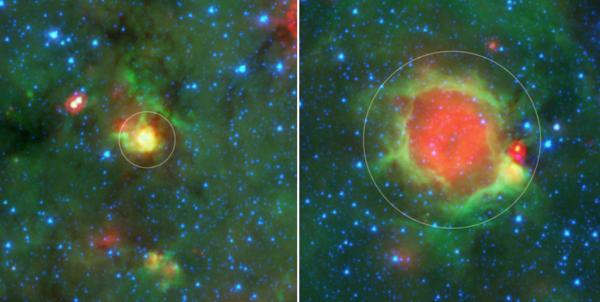In the quest to unravel the mysteries of star formation, yellowballs could be a powerful new tool. These dusty cocoons — like the one pictured above at left — harbor a cluster of newborn stars so young, they haven’t yet made their mark on their surroundings.
Yellowballs were discovered by citizen scientists participating in The Milky Way Project, part of the Zooniverse citizen science platform. Researchers had initially asked participants to identify “bubbles” of recent star formation, like the one in the image at right. But users also found hundreds of compact yellow objects, prompting one user to ask on a message board, “Any ideas what these bright yellow fuzzy objects are?”
In 2015, researchers reported that these oddballs are likely clouds of gas and dust in the very early stages of forming a star cluster. The yellow coloration is due to the way the Spitzer Space Telescope (now defunct) processed its false-color images: light emitted by complex organic molecules is depicted in green, while light from dusty regions is mapped in red. Where those regions overlap, they produce a distinctive yellow glow. Over time, the intense radiation and winds from these young stars blow material outward, causing these clouds to expand into the bubbles the team was initially seeking.
The above pair of images is from the latest version of The Milky Way Project, which kicked off in 2016. This time, researchers asked users to identify yellowballs from the start. Citizen scientists’ efforts turned up over 6,000 yellowballs, and the resulting catalog was published April 13 in The Astrophysical Journal. Many of these star-forming regions had been missed by earlier surveys. Even better, the researchers found that they can discern information about the masses and ages of the stars within a yellowball based on its precise shade of yellow, which could be a big timesaver for future surveys.










